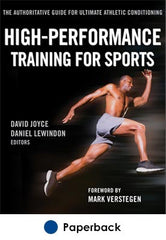How Can Tapering Improve Performance?
This is an excerpt from High-Performance Training for Sports by David Joyce & Dan Lewindon.
In high-level sport, small elevations in performance can have a significant impact on performance outcomes and can differentiate between winning and losing. For example, across the swimming events in the 2000 Sydney Olympics there was only a 1.62 per cent difference between the gold medal and fourth place and a 2.02 per cent difference between third and eighth place.34 Similarly, in the 2004 Athens Olympics there was a 1.96 per cent difference (women = 2.2%; men = 1.73%) between first and third in weightlifting.1
When looking at the variability in weightlifting performance, McGuigan and Kane35 report that the within-athlete variation in performance is around 2.5 per cent (95% confidence interval = 2.2%-2.9%) and that as little as a 1.2 per cent increase in total weight lifted can significantly enhance performance results. Similarly, at the 2012 London Olympic Games, the variation in performance between first and third was 2.3 per cent (95% confidence interval =1.7%-3.7%) across all weight classes; as little as a 1.1 per cent increase in performance would be expected to enhance performance results. Additionally, Hopkins36 suggests that elite track athletes can significantly alter their competitive placing with a 0.3 to 0.5 per cent increase in performance, whilst elite field athletes (i.e., throwers) can improve placing with improvements of 0.9 to 1.5 per cent.
After the employment of a well-crafted tapering strategy, it is reasonable to expect competitive performance enhancements of equal or greater magnitude to these variances. Research into tapering strategies has revealed that significant improvements in competitive performance (0.5%-11.0%) and muscular strength and power (8%-25%) in runners, triathletes, cyclists and swimmers can occur when properly implementing a taper before a competitive event (figure 22.5).9, 13, 15, 18, 37-42
As a general rule, a pre-event taper typically results in about a 3 per cent (0.5%-6.0%) increase in competitive performance.18, 37 For example, swimming performance was elevated by 2.2 per cent with the implementation of a 3-week taper leading into the 2000 Sydney Olympic Games.34 Interestingly, the elevation in performance stimulated by this 3-week taper is similar to the differences between first and fourth place (1.62%) and third and eighth place (2.02%) across the swimming events.16, 34
If a taper is employed to elevate muscular strength, a 2 to 8 per cent increase in performance is typically expected,1 which is greater than the 1.1 per cent increase needed to alter performance results in the sport of weightlifting.35 When examining the effects of a taper on bench press and back squat performance, Izquierdo and colleagues43 report a 2.0 per cent increase in maximal strength; Coutts and colleagues44 report a 7.2 per cent increase in 3RM back squat performance and a 5.2 per cent increase in bench press performance. Similarly, Gibala and colleagues45 report a 3 to 8 per cent increase in maximal isometric and dynamic force-generating capacity when a taper is employed.
If these results are taken collectively, it is clear that a properly constructed taper can produce increases in performance.5 The overall effectiveness of the planned taper is related to many factors, including the type of taper selected.18 In general one can expect to see a 3.0 per cent increase in performance in response to a taper. This magnitude of performance increase can differentiate between first and third place at the Olympic Games.
Read more from High-Performance Training for Sports by David Joyce and Dan Lewindon.
More Excerpts From High Performance Training for Sports

Get the latest insights with regular newsletters, plus periodic product information and special insider offers.
JOIN NOW


